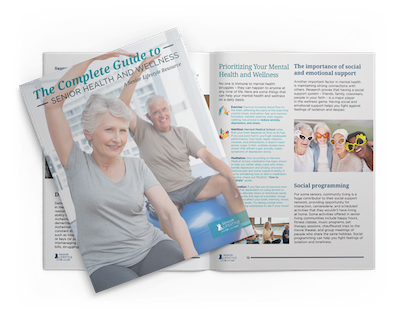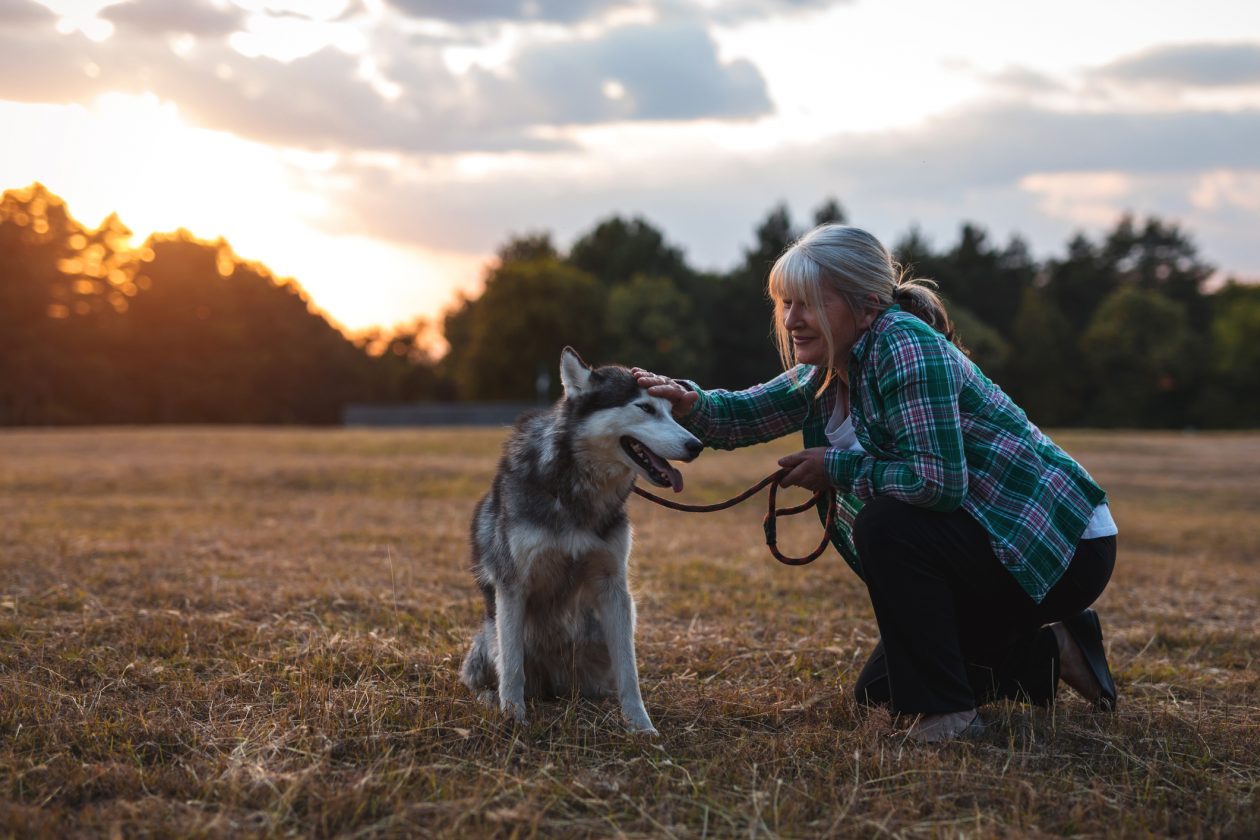As they age, seniors face a litany of new challenges to their well-being. Even as the COVID-19 pandemic is affecting the world, seniors are among the most vulnerable population to the deadly virus.
Along with monitoring their physical health, seniors are being encouraged to support their mental health. Especially now, self-care during coronavirus can be even more important.
Self-care is defined in many ways, according to the International Self-Care Foundation, but the World Health Organization has a helpful take on the term: “Self-Care is what people do for themselves to establish and maintain health, and to prevent and deal with illness.” The WHO factors in environmental factors, hygiene, lifestyle and nutrition into its holistic view of self-care.
Find out more about self-care for seniors and some activities to support mental and physical care for seniors.
7 Self-Care Activities for Seniors
Here are 7 ways seniors can take care of themselves:
- Connect With Others
- Give Thanks
- Practice Mindfulness and Relaxation
- Consider Prayer
- Read a New Book
- Do Something Creative
- Prioritize Your Physical Health
1. Connect With Others
As Americans get older, they are more likely to live alone. According to the Administration for Community Living, a division of the U.S. Department of Health and Human Services, about 28% of older persons live alone – 9.3 million women and 4.5 million men.
A study by financial investments firm Edward Jones makes a distinction between being alone and feeling lonely ‒ disconnected and ignored. Their study indicates that many older adults possess self-sufficiency and resilience, which makes them feel less lonely despite being more socially isolated.
This is especially heightened during a time of forced isolation and quarantine during COVID-19. From the International Council on Active Aging, here are some ways to stay connected during lockdown:
- Call someone. Not all connections have to be high-tech. Use the phone to connect with grandkids, family and friends you haven’t heard from in a while.
- Check on your neighbors. From a safe distance, make sure those around you are doing well, and ask whether they need anything you can help with.
- Exercise safely. You can get together outdoors with a friend, keeping a safe distance, of course. Or, you can join an online exercise opportunity, such as with the Peloton bike community.
- Join groups and clubs. Discussion groups and book clubs are meeting online. Livestreams on subjects that interest you can also include chat opportunities.
- Spend time outside. Use the opportunity to interact with neighbors or people making deliveries. Set up chairs at a safe distance and encourage others to stay and talk awhile.
- Use technology. Apps and websites can connect people for conversation, activities, even dinner and a movie. This Senior Lifestyle article lists apps and sites that can help you connect.
2. Give Thanks
Evidence continues to show that gratitude is associated with many benefits. A paper by the Greater Good Science Center at the University of California at Berkeley indicates that among these benefits are better physical and psychological health, greater happiness and life satisfaction, higher self-esteem, less materialism, less negativity, and more.
There are many techniques experts advise to help build a sense of gratitude. Among the ways to give thanks:
- Begin each day by giving thanks. Be thankful for days of good health, for shelter, for friends and family. Take time to really savor the feelings of thankfulness.
- Give back. You might donate to a charity or volunteer to make phone calls for a community group. This can give you a sense of purpose while connecting with others.
- Keep a gratitude journal. You could note big things, such as the opportunity to see a friend or family member, or small things like experiencing a restful nap. The key is to identify new things to feel grateful for.
- Practice mindfulness. Slow down and appreciate all the little things, such as pleasant weather, the sound of a familiar voice, your favorite music. This can bring you clarity, comfort and peace.
- Say thank you every day. Just smiling or holding open a door or saying “thank you” can open you up to more feelings of gratitude.
- Share messages of thanks. Writer letters or send packages to the important people in your life. Taking time to express how you feel can be an enriching and fulfilling experience.
As people grow older, their health and wellness needs change. Read our eBook, “The Complete Guide to Health & Wellness for Seniors” for everything you need to know about staying healthy and happy as we age.
Download The Complete Guide to Health & Wellness for Seniors
3. Practice Mindfulness and Relaxation
Mindfulness has entered the American mainstream in recent years from its roots in Buddhist meditation. According to the Mayo Clinic, mindfulness is being intensely aware of what you’re sensing and feeling in the moment, free from interpretation or judgment.
This type of meditation can involve breathing methods, guided imagery, and other practices to relax the body and mind and help reduce stress. There are many other benefits of mindfulness and meditation for seniors, as shown in this Senior Lifestyle article.
Here are 8 things you can do to practice mindfulness every day:
- Go for a walk or be in nature. Take in the sights, sounds and even smells of the outdoors.
- Listen to relaxing music or sounds. Calm piano music or the sound of a gentle rain or babbling brook water stream can be a great relief.
- Meditate. Take a yoga posture, or find a comfortable chair in a quiet place, where you can find peace.
- Practice deep, controlled breathing. Cleansing breaths can slow your heart, lower your blood pressure and raise your self-awareness.
- Take in your surroundings. See things as you never have before, appreciating the uniqueness of your place and time.
- Try aromatherapy. The cozy, comforting scent of fresh-baked cookies or the ocean shore can be duplicated with candles or essential oils.
- Turn off the television or computer. This practical step can help you step away from the urgent and let you experience the timeless.
- Use apps. From your phone or laptop, you can get guidance in your mindfulness and meditation. Among the apps available are:
4. Consider Prayer
Meditation and prayer can have a lot in common, but they are different. While meditation focuses on clearing the mind through one’s solitary life journey, prayer entails working through thoughts and circumstances while experiencing a relationship with a higher power.
Studies and articles recently have reinforced the positive effects of prayer and religious faith:
- According to a recent study from Gallup, the only people who experienced a positive change in mental health from 2019 to 2020 were those who attended a religious service weekly.
- An article from CNN reports that prayer can decrease feelings of fear, anxiety, stress and isolation. The article also notes that prayer has been associated with feelings of peace, encouragement and social support.
There are many different ways to pray, and different faiths may require different methods, such as using particular texts or following certain schedules. Some of the more common ways to pray include:
- Pray at a set time. A morning prayer opens the day with hopefulness and lets you seek help for the challenges ahead. An evening prayer helps you give thanks for God’s hand in your day.
- Pray by journaling. Sum up the thoughts of the day or your most recent scripture reading and turn this into a prayer.
- Pray informally. This may be on a walk or at a suddenly quiet time of the day. Express your thoughts and feelings without resorting to “religious” language.
- Pray silently. Prayer is not only about requesting from God; it’s about hearing, too. Use your prayer time to listen.
- Pray with a friend. Teaming up for prayer can help keep you accountable, and will encourage you to ask for prayer from your teammate. You’ll also get the blessing of praying for someone else’s needs.
- Pray your heart. What’s at the top of your mind? What are you wrestling with? Who are you thinking about? This is a good place to start your prayer.
5. Read a New Book
Reading can lower blood pressure, decrease heart rate and reduce stress, according to a study by the University of Sussex. Only six minutes of reading can reduce stress up to 68%, more than having a cup of tea or listening to music. Reading of any kind can let you escape to a new place, or to learn something new.
Don’t know where to start? There are a few sites that can help you find your interests and give you recommendations for interesting books.
- Bookish – This site features articles with recommendations and lists of books to read.
- Goodreads – You can start lists of books you’ve read, books you want to read, and even connect with other people to see what they’re reading. When you sign up, you can get recommendations according to your interests.
- LibraryThing – This is another list builder, which will keep track of your owned books and wishlist books. When you sign up and fill in your preferences, you can get a long list of recommendations.
- What Should I Read Next? – Type in the title of an author or a book you’ve read, and you’ll get some new book ideas. Also search by genre or interests.
- Whichbook – This site can search for books by your mood, or location you’re interested in, or the characters in the book, and more.
If you’re looking to economize, remember to make use of your nearest library or look for free ebooks that can be read on a device like Kindle. Find them here:
Don’t let vision issues stop you from exploring the world of books. Audiobooks are a great way to get up to date on literature. Find some free audiobooks here:
6. Do Something Creative
Creativity brings your imagination into play, which is a terrific way to reduce stress and exercise your mind. The stress-related hormone cortisol can drop significantly after just 45 minutes of making art, according to a study published by the Journal of the American Art Therapy Association.
But art isn’t the only way to engage your creativity. Hobbies, music, cooking – anything that you can create can give you the benefits of stress reduction. Here are some things you can do to unleash your creativity:
- Compose a poem – Try haikus instead of regular rhyming schemes just to mix it up.
- Cook something new – Food can be an expressive medium. Try a new dish, a new technique, or use a new kitchen gadget.
- Draw or paint a picture – Use pencil and paper or a computer tablet. Try oils, pastels and watercolors. Whatever you use, let your imagination flow.
- Grow a garden – Add color and personality to your yard by planting flowers, herbs or vegetables.
- Start a scrapbook – Dig through your memories with old photos and ephemera. It can be dressed up and shown to family and friends.
- Take pictures – Photography doesn’t have to be expensive. Use your phone’s camera to document your neighborhood.
- Write a story – Fiction, nonfiction, short story, memoir – whatever you choose to write, get it down on paper or on the screen without worrying about perfection.
For more ideas, Pinterest can be a deep well of inspiration.
7. Prioritize Your Physical Health
In addition to getting plenty of sleep and eating healthy foods, make sure you’re making time for exercise. The benefits of physical activity, in particular, are many for seniors, according to the Centers for Disease Control and Prevention.
The CDC says activity can help reduce the risks of:
- Colon cancer
- Coronary heart disease
- Diabetes
- Falling
- Fracturing bones
- High blood pressure
It can also help:
- Build stamina and muscle strength
- Control joint swelling and pain associated with arthritis
- Improve mood and feelings of well-being
- Maintain healthy bones, joints and muscles
Senior Lifestyle has offered tips for maintaining health. Read these articles to find out more:
- 5 Simple and Fun Water Aerobics Exercises for Seniors
- 7 Best Exercises for Seniors (and a Few to Avoid!)
- Common Health Concerns for Seniors as They Age
- Senior Nutrition: Healthy Meals for the Elderly
- Top 10 Chair Yoga Positions for Seniors
Learn More About Senior Self-Care and Wellness
Find out more about senior self-care and wellness at our archive of articles. To find out more about Senior Lifestyle’s innovative health programming, reach out to a community near you today.

